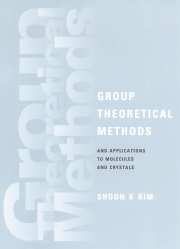Book contents
- Frontmatter
- Contents
- Preface
- List of symbols
- 1 Linear transformations
- 2 The theory of matrix transformations
- 3 Elements of abstract group theory
- 4 Unitary and orthogonal groups
- 5 The point groups of finite order
- 6 Theory of group representations
- 7 Construction of symmetry-adapted linear combinations based on the correspondence theorem
- 8 Subduced and induced representations
- 9 Elements of continuous groups
- 10 The representations of the rotation group
- 11 Single- and double-valued representations of point groups
- 12 Projective representations
- 13 The 230 space groups
- 14 Representations of the space groups
- 15 Applications of unirreps of space groups to energy bands and vibrational modes of crystals
- 16 Time reversal, anti-unitary point groups and their co-representations
- 17 Anti-unitary space groups and their co-representations
- Appendix Character tables of the crystal point groups
- References
- Index
8 - Subduced and induced representations
Published online by Cambridge University Press: 12 November 2009
- Frontmatter
- Contents
- Preface
- List of symbols
- 1 Linear transformations
- 2 The theory of matrix transformations
- 3 Elements of abstract group theory
- 4 Unitary and orthogonal groups
- 5 The point groups of finite order
- 6 Theory of group representations
- 7 Construction of symmetry-adapted linear combinations based on the correspondence theorem
- 8 Subduced and induced representations
- 9 Elements of continuous groups
- 10 The representations of the rotation group
- 11 Single- and double-valued representations of point groups
- 12 Projective representations
- 13 The 230 space groups
- 14 Representations of the space groups
- 15 Applications of unirreps of space groups to energy bands and vibrational modes of crystals
- 16 Time reversal, anti-unitary point groups and their co-representations
- 17 Anti-unitary space groups and their co-representations
- Appendix Character tables of the crystal point groups
- References
- Index
Summary
Let G be a finite group and H be a subgroup of G. Then a representation of the group G automatically describes a representation of the subgroup H of G. Such a representation is called a representation of H subduced by a representation of G. Conversely, from a given representation of a subgroup H of G we can form a representation of the group G. Such a representation is called a representation of G induced by a representation of its subgroup H. The problem is to form the irreducible representations (irreps in short) of G from the irreps of its subgroup H. If the group G is finite and solvable (see Section 8.4.1), the problem of forming the irreps of G may be solved by a step-by-step procedure from the trivial irrep of the trivial identity subgroup. This method is possible, for example, for a crystallographic point group. An alternative approach is via the induced irreps of G from the so-called small representations of the little groups of the irreps of H. As a preparation, we shall discuss subduced representations first.
Subduced representations
Let G = {g} be a group and H = {h} be a subgroup of G. Let Γ(G) = {Γ(g); g ∈ G} be a representation of G, then it provides a representation of H by {Γ(h); h ∈ H}. This representation is called the subduced representation of Γ(G) onto H or the representation of H subduced by the representation Γ(G).
- Type
- Chapter
- Information
- Publisher: Cambridge University PressPrint publication year: 1999

